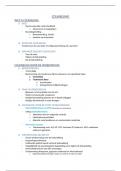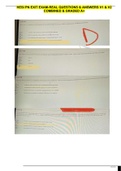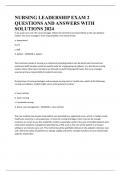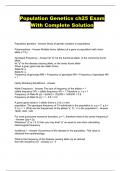TEST BANK
Financial Markets and Institutions 8th Edition
by Anthony Saunders, Marcia Cornett, All Chapters 1 - 25,
Version 1 1
,Chapter 1: Introduction
Chapter 2: Determinants of Interest Rates Chapter
3: Interest Rates and Security Valuation
Chapter 4: The Federal Reserve System, Monetary Policy, and Interest Rates Chapter 5:
Money Markets
Chapter 6: Bond Markets Chapter
7: Mortgage Markets Chapter 8:
Stock Markets
Chapter 9: Foreign Exchange Markets Chapter
10: Derivative Securities Markets Chapter 11:
Commercial Banks
Chapter 12: Commercial Banks’ Financial Statements and Analysis
Chapter 13: Regulation of Commercial Banks
Chapter 14: Other Lending Institutions
Chapter 15: Insurance Companies
Chapter 16: Securities Firms and Investment Banks Chapter
17: Investment Companies
Chapter 18: Pension Funds
Chapter 19: Fintech Companies
Chapter 20: Types of Risks Incurred by Financial Institutions
Chapter 21: Managing Credit Risk on the Balance Sheet Chapter
22: Managing Liquidity Risk on the Balance Sheet
Chapter 23: Managing Interest Rate Risk and Insolvency Risk on the Balance Sheet
Chapter 24: Managing Risk off the Balance Sheet with Derivative Securities
Chapter 25: Managing Risk off the Balance Sheet with Loan Sales and Securitization
Version 1 2
,Chapter 1
Student name:
1) What factors are encouraging financial institutions to offer overlapping financial services
such as banking, investment banking, brokerage, etc.? 1.I. Regulatory changes allowing
institutions to offer more services
2.II. Technological improvements reducing the cost of providing financial services
3.III. Increasing competition from full-service global financial institutions
4.IV. Reduction in the need to manage risk at financial institutions
A) I only
B) II and III only
C) I, II, and III only
D) I, II, and IV only
E) I, II, III, and IV
2) IBM creates and sells additional stock to the investment banker Morgan Stanley. Morgan
Stanley then resells the issue to the U.S. public through its mutual funds.
This transaction is an example of a(n):
A) primary market transaction.
B) asset transformation by Morgan Stanley.
C) money market transaction.
D) foreign exchange transaction.
E) forward transaction.
Version 1 3
,3) IBM creates and sells additional stock to the investment banker Morgan Stanley. Morgan
Stanley then resells the issue to the U.S. public through its mutual funds.
Morgan Stanley is acting as a(n)
A) asset transformer.
B) asset broker.
C) government regulator.
D) foreign service representative.
E) derivatives trader.
4) A corporation seeking to sell new equity securities to the public for the first time in order to
raise cash for capital investment would most likely:
A) conduct an IPO with the assistance of an investment banker.
B) engage in a secondary market sale of equity.
C) conduct a private placement to a large number of potential buyers.
D) place an ad in the Wall Street Journal soliciting retail suppliers of funds.
E) issue bonds with the assistance of a dealer.
5) The largest capital market security outstanding in 2019 measured by market value was:
A) securitized mortgages.
B) corporate bonds.
C) municipal bonds.
D) Treasury bonds.
E) corporate stocks.
Version 1 4
,6) The diagram below is a diagram of the:
A) secondary markets.
B) primary markets.
C) money markets.
D) derivatives markets.
E) commodities markets.
7) and allow a financial intermediary to offer safe liquid liabilities
such as deposits while investing the depositors' money in riskier illiquid assets.
A) Diversification; high equity returns
B) Price risk; collateral
C) Free riders; regulations
D) Monitoring; diversification
E) Primary markets; foreign exchange markets
8) Depository institutions include:
A) banks only.
B) thrifts only.
C) finance companies only.
D) banks and thrifts.
E) All of these choices are correct.
Version 1 5
,9) Match the intermediary with the characteristic that best describes its function. 1.I.
Provide protection from adverse events
2.II. Pool funds of small savers and invest in either money or capital markets
3.III. Provide consumer loans and real estate loans funded by deposits
4.IV. Accumulate and transfer wealth from work period to retirement period
5.V. Underwrite and trade securities and provide brokerage services
1. Thrifts
2.Insurers
3. Pension funds
4. Securities firms and investment banks
5. Mutual funds
A) 1, 3, 2, 5, 4
B) 4, 2, 3, 5, 1
C) 2, 5, 1, 3, 4
D) 2, 4, 5, 3, 1
E) 5, 1, 3, 2, 4
10) Secondary markets help support primary markets because secondary markets: 1.I. offer
primary market purchasers liquidity for their holdings.
2. II. update the price or value of the primary market claims.
3.III. . reduce the cost of trading the primary market claims.
A) I only
B) II only
C) I and II only
D) II and III only
E) I, II, and III
11) Financial intermediaries (FIs) can offer savers a safer, more liquid investment than a
capital market security, even though the intermediary invests in risky illiquid instruments
because:
Version 1 6
, A) FIs can diversify away some of their risk.
B) FIs closely monitor the riskiness of their assets.
C) the federal government requires them to do so.
D) FIs can diversify away some of their risk and closely monitor the riskiness of their
assets.
E) FIs can diversify away some of their risk and the federal government requires them
to do so.
12) Households are increasingly likely to both directly purchase securities (perhaps via a broker)
and also place some money with a bank or thrift to meet different needs. Match the given investor's
desire with the appropriate intermediary or direct security.
1.I. Money likely to be needed within six months
2.II. Money to be set aside for college in 10 years
3.III. Money to provide supplemental retirement income
4. IV. Money to be used to provide for children in the event of death
1. Depository institutions
2.Insurer
3. Pension fund
4. Stocks or bonds
A) 2, 3, 4, 1
B) 1, 4, 2, 3
C) 3, 2, 1, 4
D) 1, 4, 3, 2
E) 4, 2, 1, 3
13) As of 2019, which one of the following derivatives instruments had the greatest amount
of notional principal outstanding?
Version 1 7
, A) Futures
B) Swaps
C) Options
D) Bonds
E) Forwards
14) Which of the following is/are money market instrument(s)?
A) Negotiable CDs
B) Common stock
C) T-bonds
D) 4-year maturity corporate bond
E) Negotiable CDs, common stock, and T-bonds
15) The Securities Exchange Commission (SEC) does not:
A) decide whether a public issue is fairly priced.
B) decide whether a firm making a public issue has provided enough information for
investors to decide whether the issue is fairly priced.
C) require exchanges to monitor trading to prevent insider trading.
D) attempt to reduce excessive price fluctuations.
E) monitor the major securities exchanges.
16) The most diversified type of depository institutions is:
Version 1 8
, A) credit unions.
B) savings associations.
C) commercial banks.
D) finance companies.
E) mutual funds.
17) Insolvency risk at a financial intermediary (FI) is the risk:
A) that promised cash flows from loans and securities held by FIs may not be paid in
full.
B) incurred by an FI when the maturities of its assets and liabilities do not match.
C) that a sudden surge in liability withdrawals may require an FI to liquidate assets
quickly at fire sale prices.
D) incurred by an FI when its investments in technology do not result in cost savings or
revenue growth.
E) that an FI may not have enough capital to offset a sudden decline in the value of its
assets.
18) Depository institutions (DIs) play an important role in the transmission of monetary
policy from the Federal Reserve to the rest of the economy because:
A) loans to corporations are part of the money supply.
B) bank and thrift loans are tightly regulated.
C) U.S. DIs compete with foreign financial institutions.
D) DI deposits are a major portion of the money supply.
E) thrifts provide a large amount of credit to finance residential real estate.
19) Liquidity risk at a financial intermediary (FI) is the risk:
Version 1 9
, A) that promised cash flows from loans and securities held by FIs may not be paid in
full.
B) incurred by an FI when the maturities of its assets and liabilities do not match.
C) that a sudden surge in liability withdrawals may require an FI to liquidate assets
quickly at fire sale prices.
D) incurred by an FI when its investments in technology do not result in cost savings or
revenue growth.
E) that an FI may not have enough capital to offset a sudden decline in the value of its
assets.
20) Money markets trade securities that: 1.I. mature in one year or less.
2.II. have little chance of loss of principal.
3.III. must be guaranteed by the federal government.
A) I only
B) II only
C) I and II only
D) I and III only
E) I, II, and III
21) Which of the following are capital market instruments?
A) 10-year corporate bonds
B) 30-year mortgages
C) 20-year Treasury bonds
D) 15-year U.S. government agency bonds
E) All of these choices are correct.
22) Commercial paper is a:
Version 1 10










